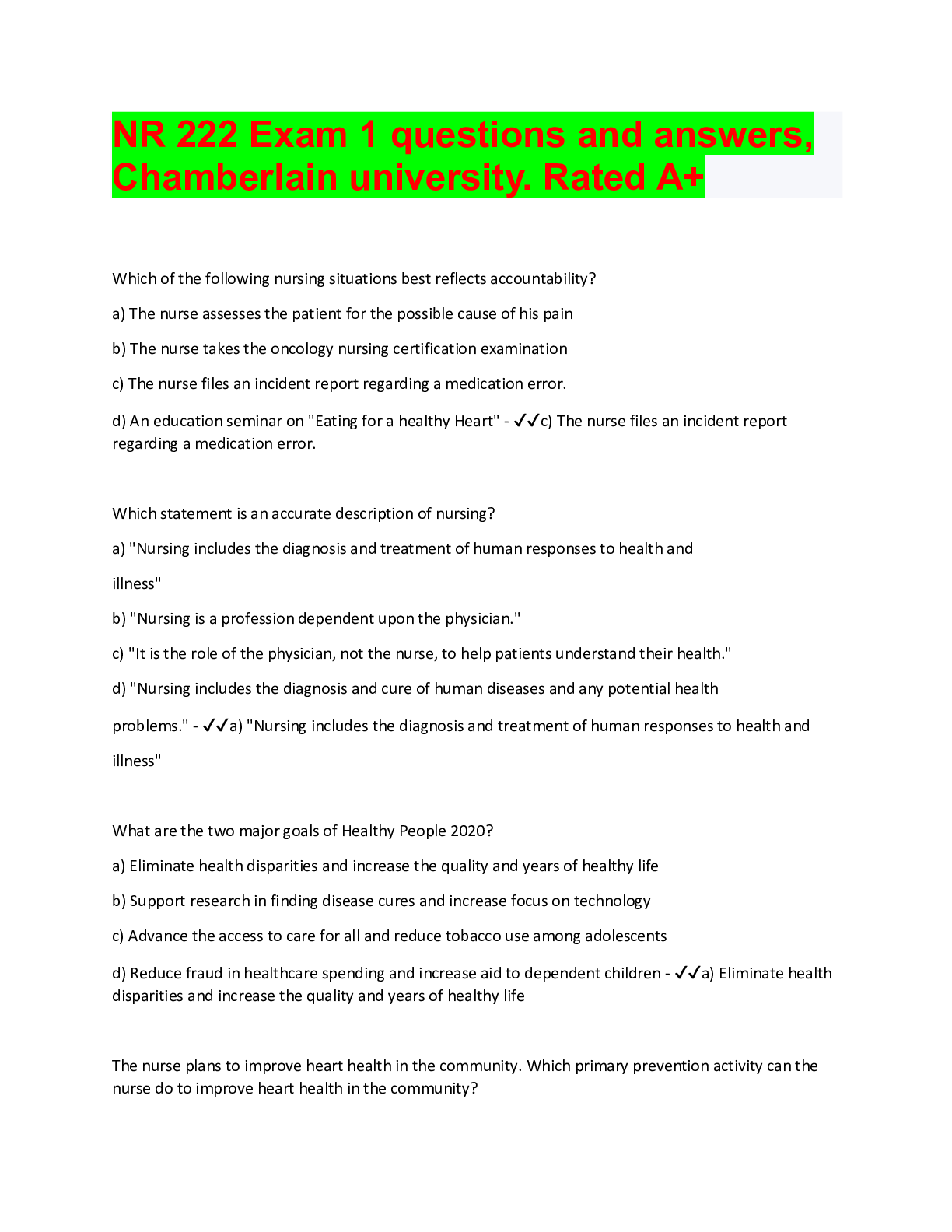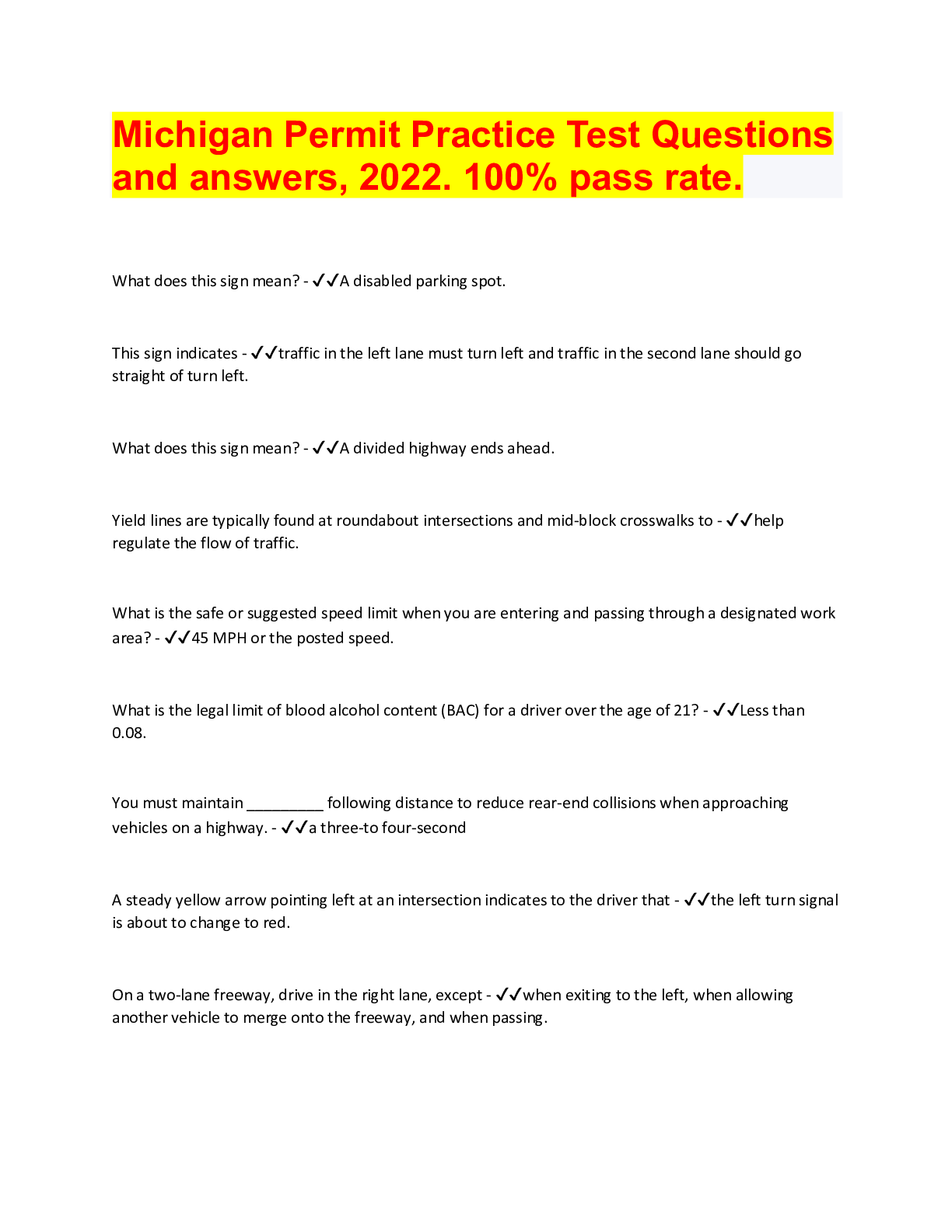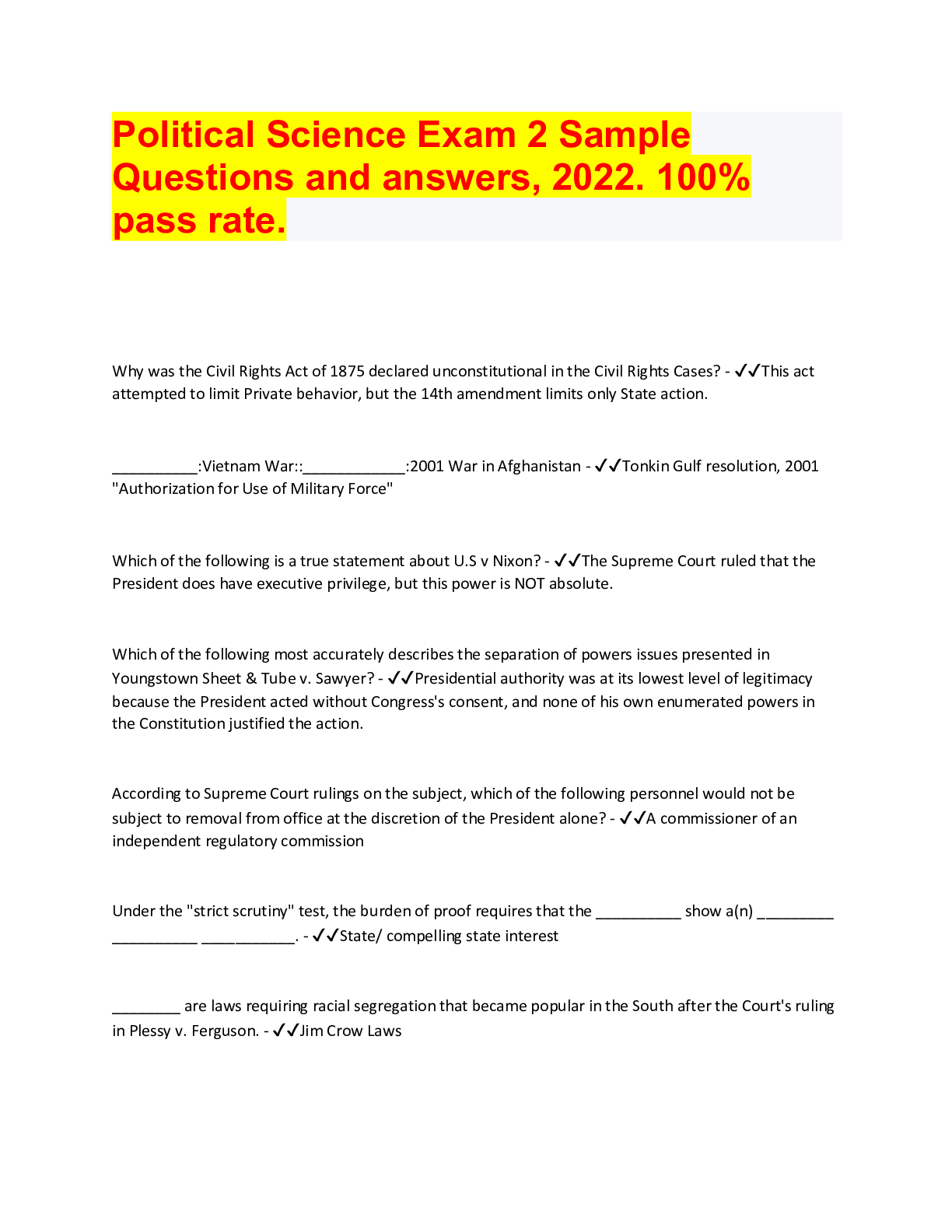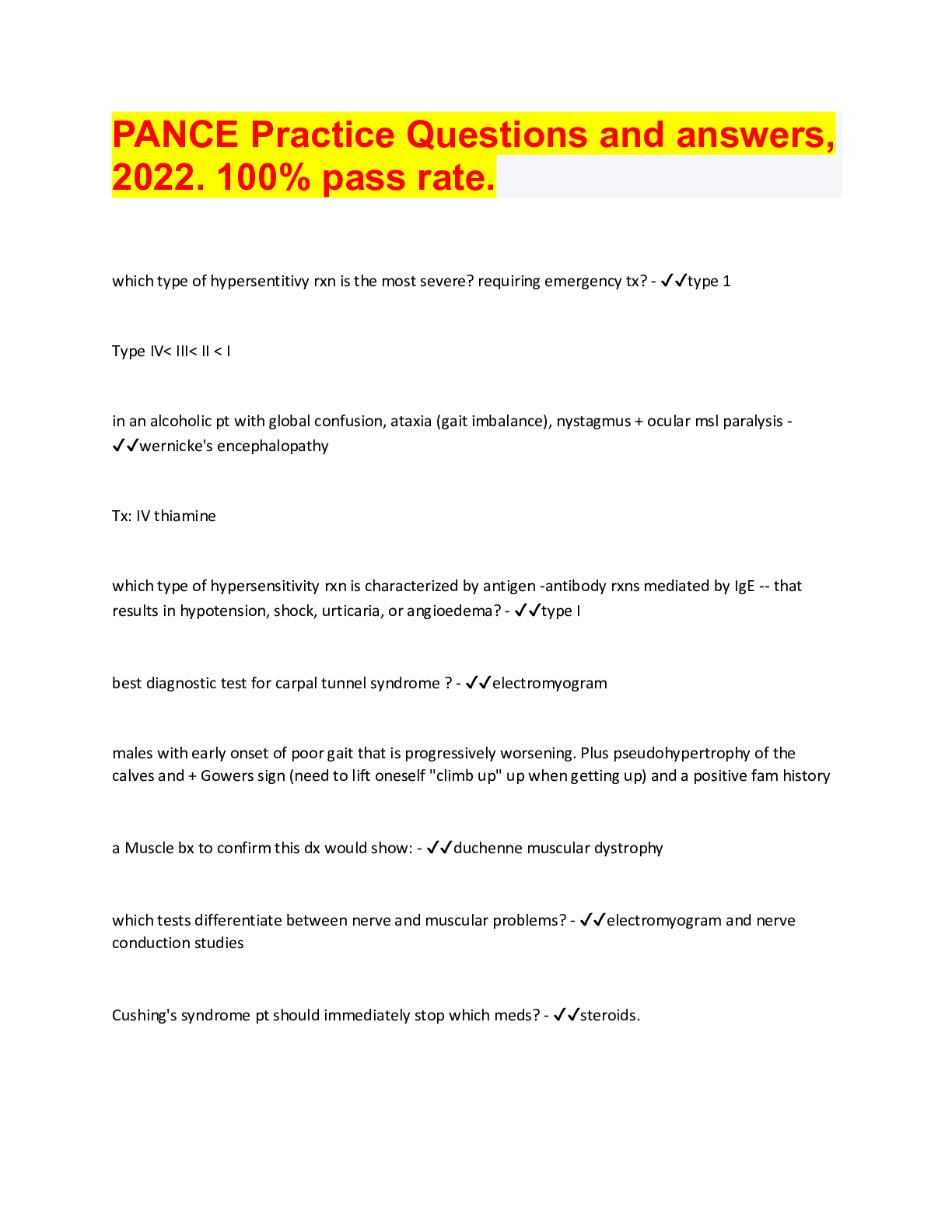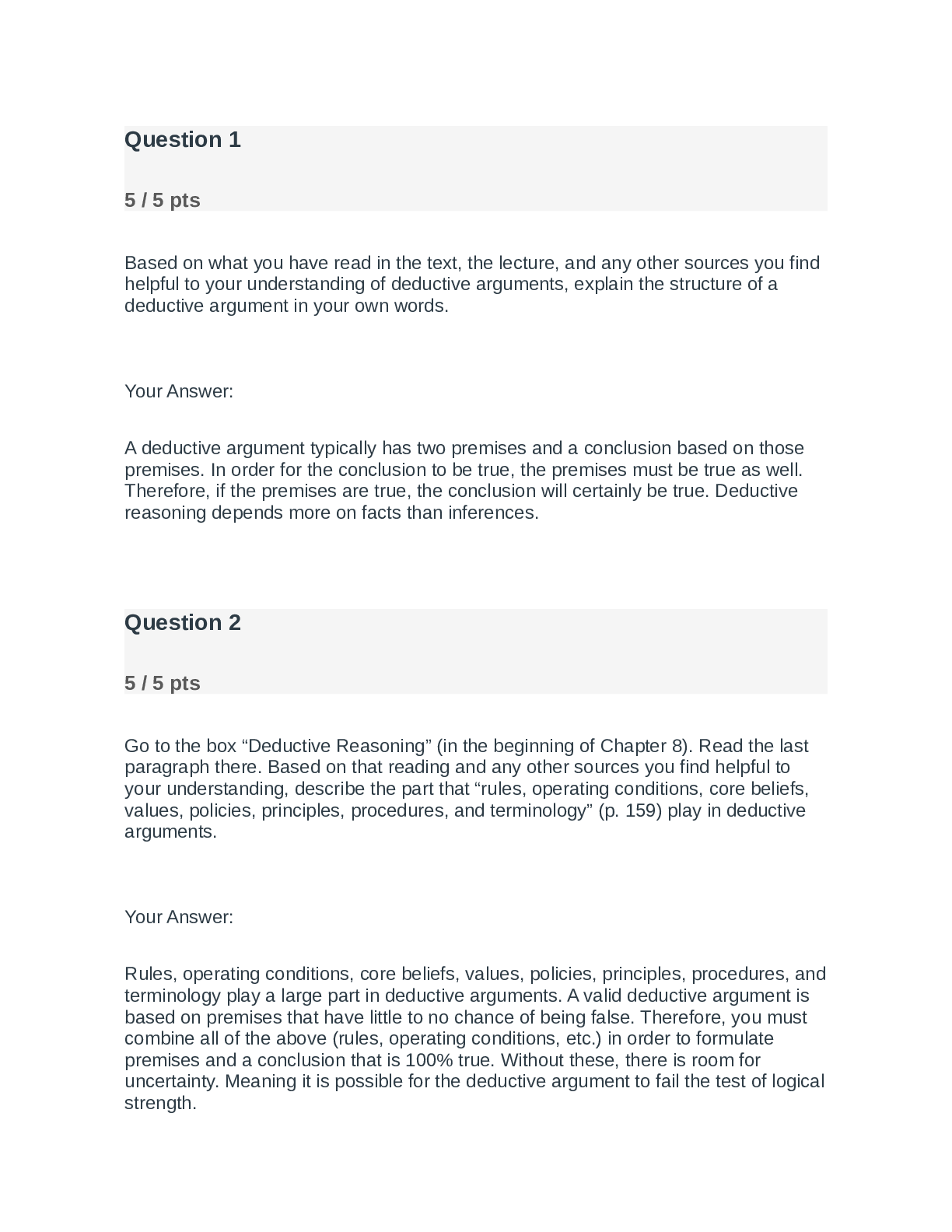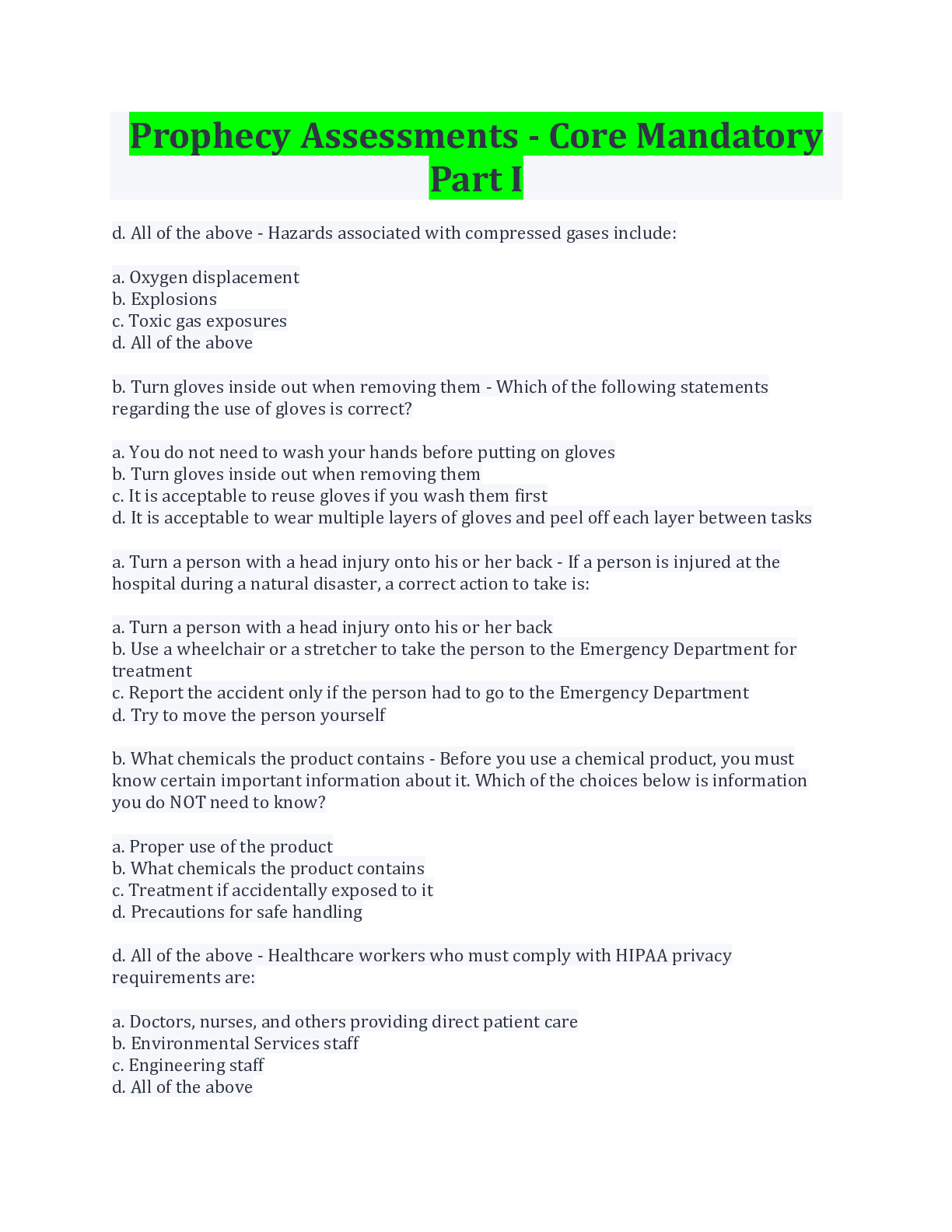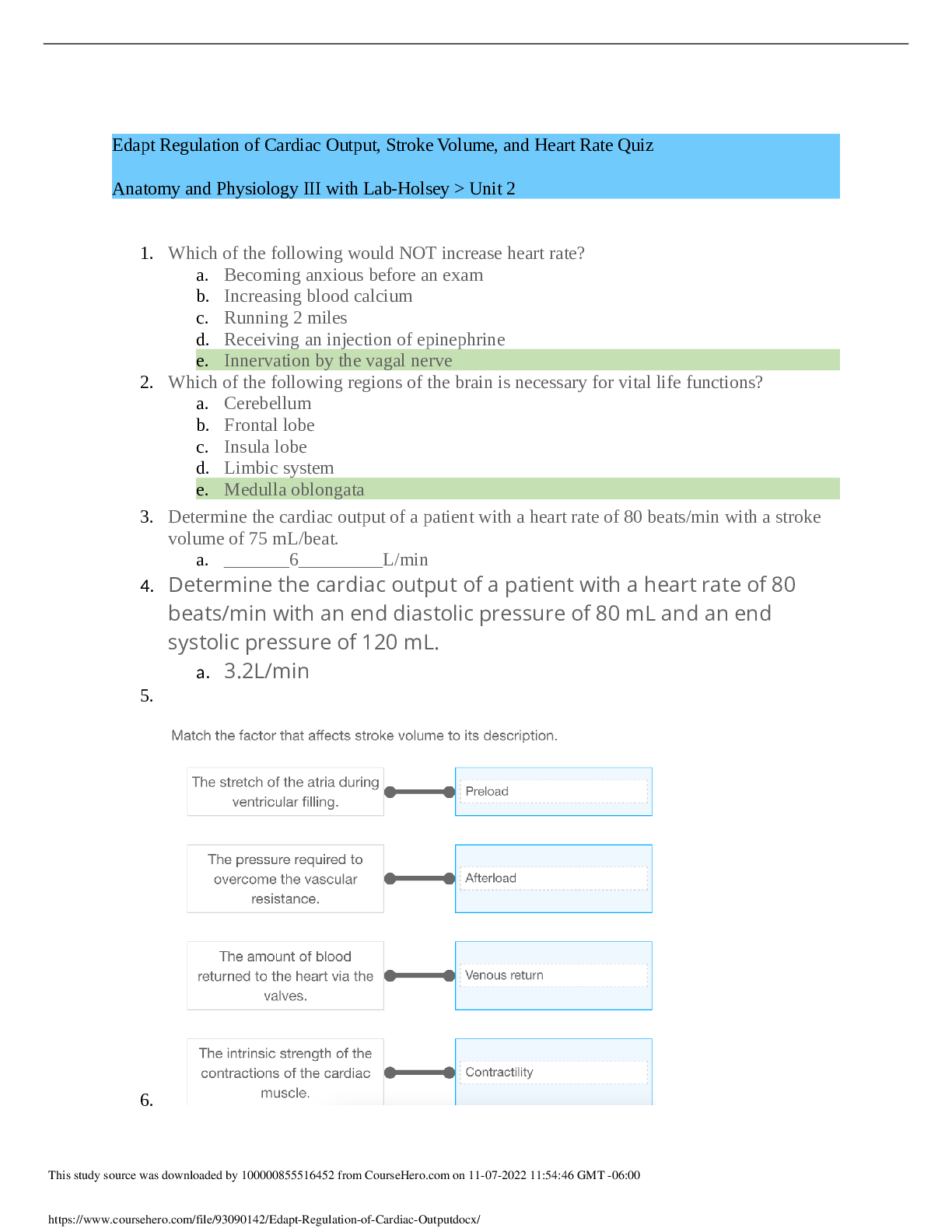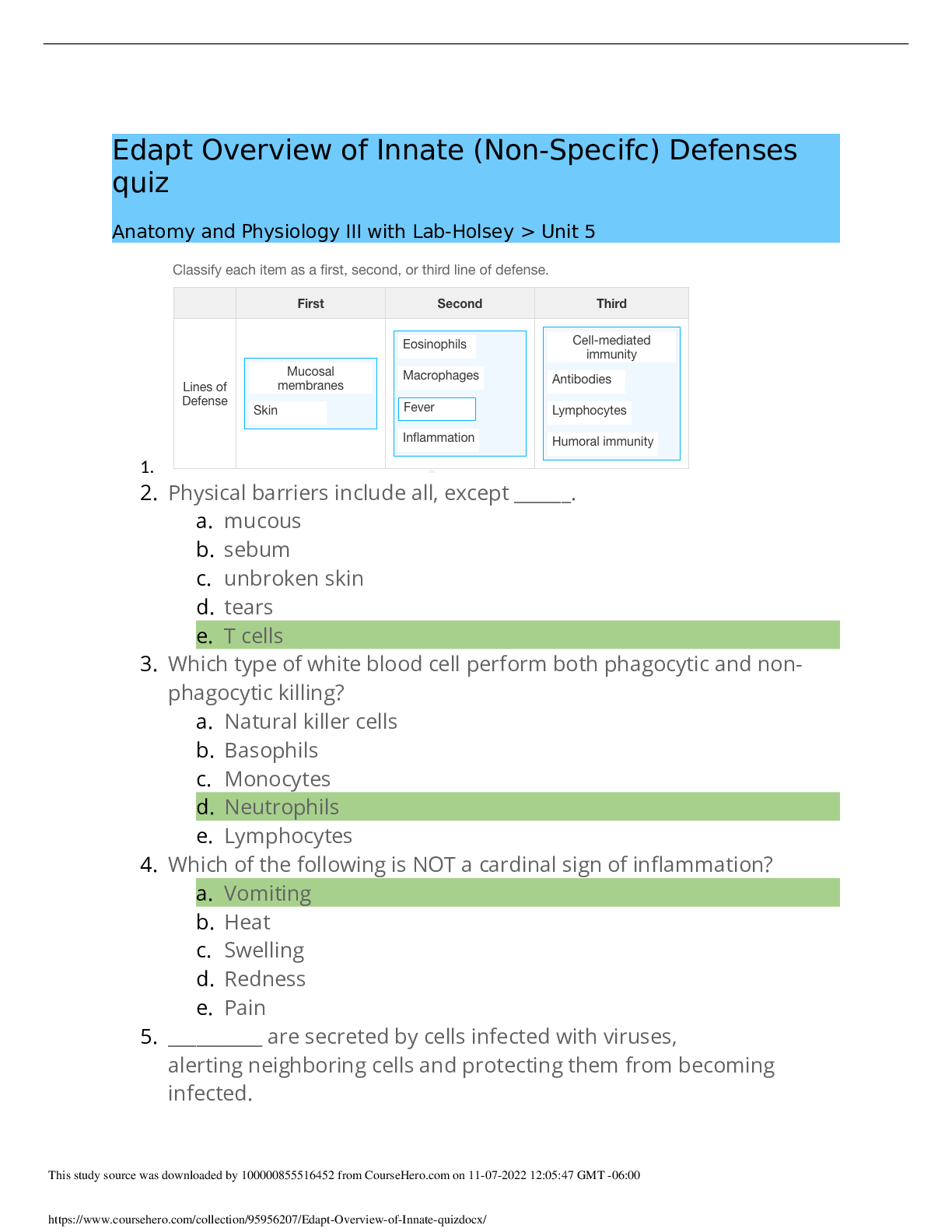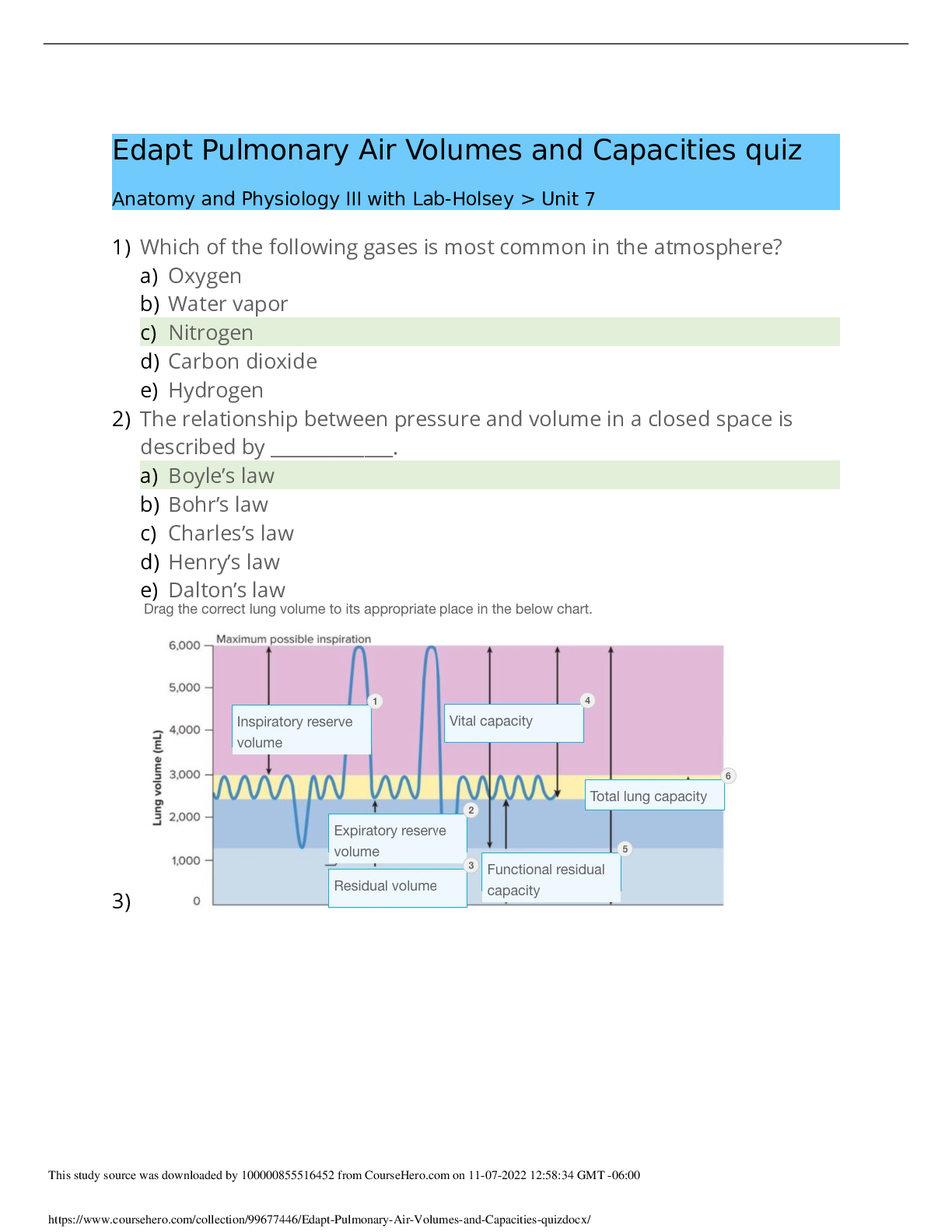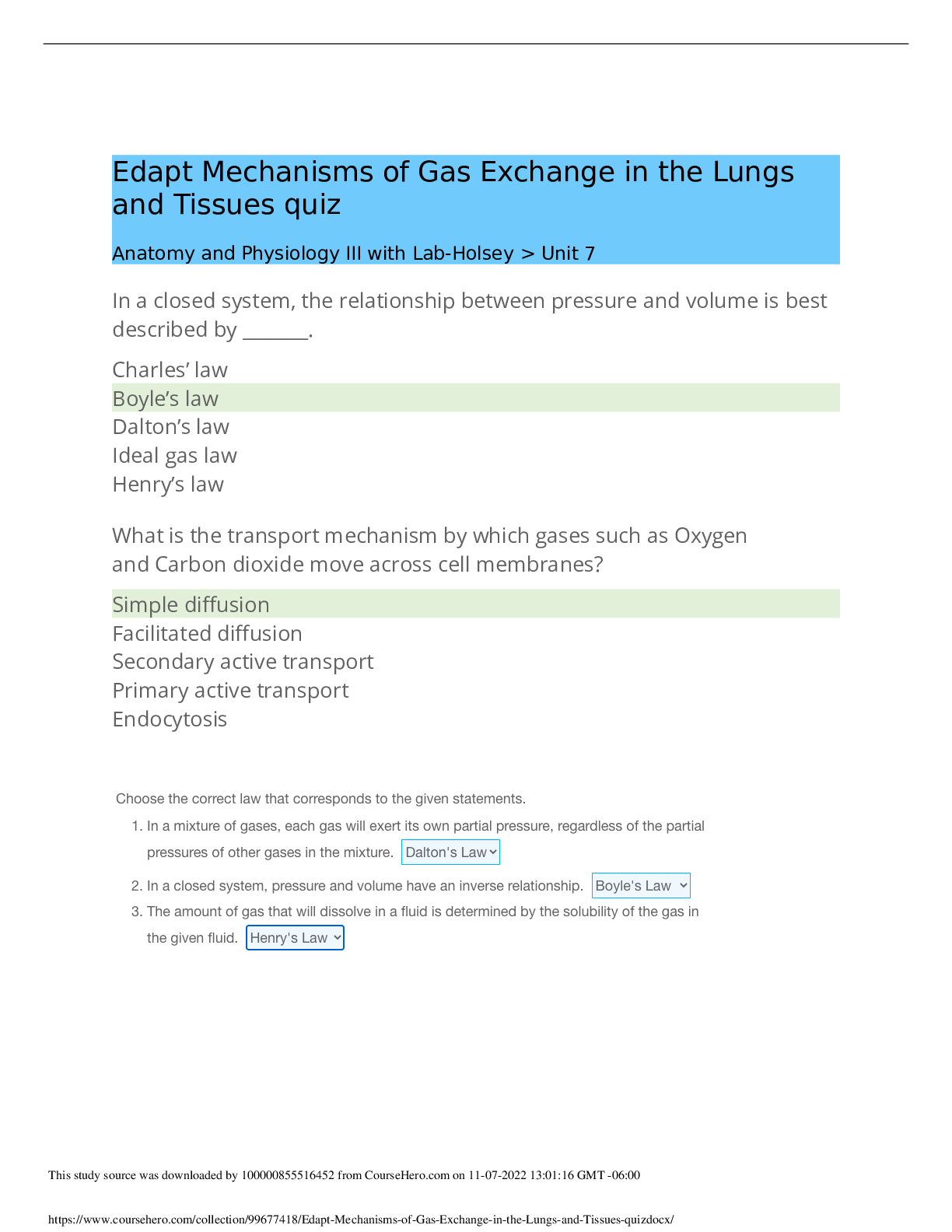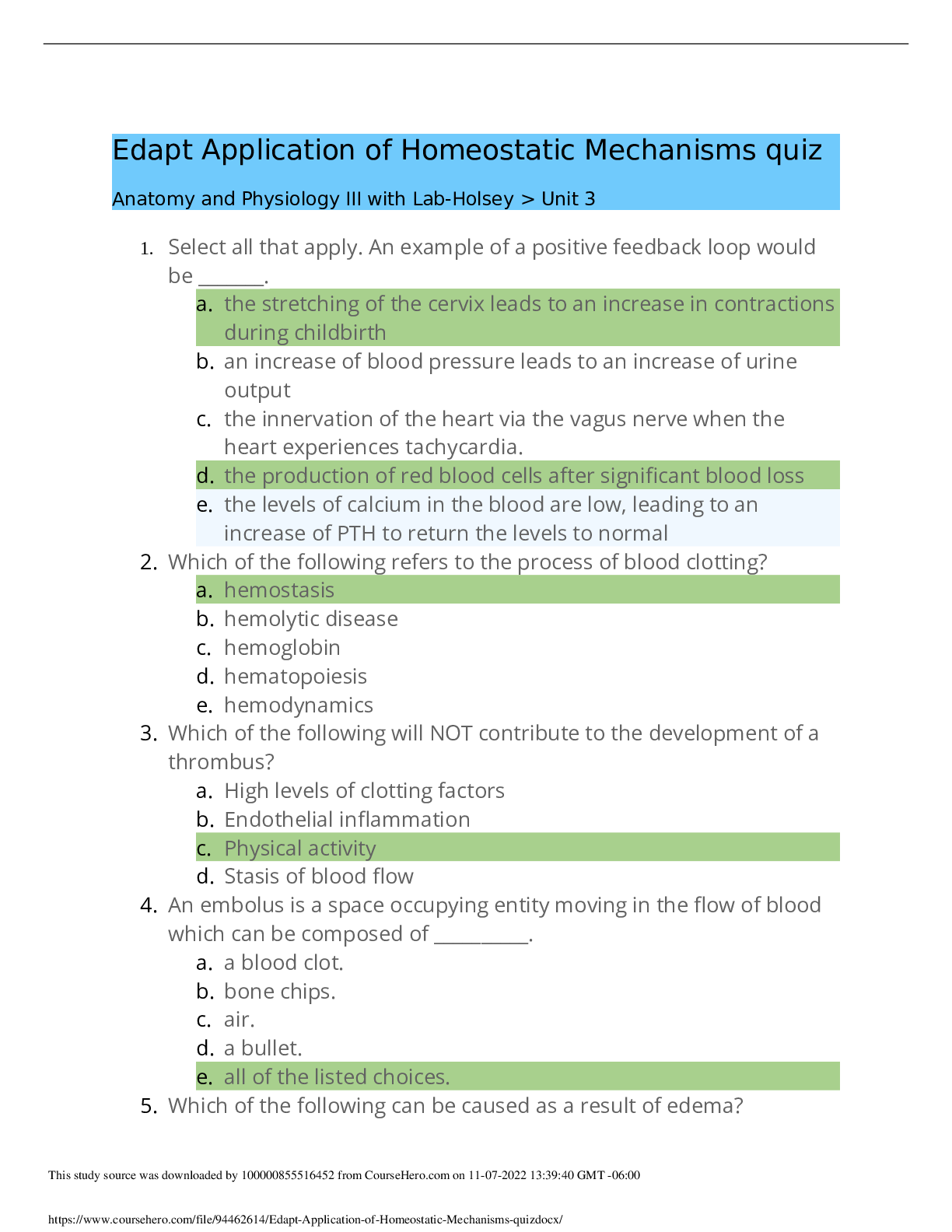*NURSING > QUESTIONS & ANSWERS > PA Easy Cardio, Questions and answers, 2022. 100% pass rate. (All)
PA Easy Cardio, Questions and answers, 2022. 100% pass rate.
Document Content and Description Below
PA Easy Cardio, Questions and answers, 2022. 100% pass rate. A 68-year-old woman with a history of hypertension and diabetes mellitus type 2 comes to the emergency department with her son, who no... ticed that while decorating for Christmas she seemed more dyspneic than normal, and had to sit down frequently. In addition, he noticed that she was pale and diaphoretic, and insisted on driving her to the emergency department. On questioning, she denies chest pain, but admits to being more fatigued than usual, with frequent jaw discomfort during activity. Activities such as vacuuming her house cause dyspnea, and she now has to stop several times while carrying laundry up from the basement. On physical examination, the patient's blood pressure is 90/50, pulse 99 bpm, respirations 22, and she is afebrile. Auscultation of the chest demonstrates a new systolic murmur. An EKG demonstrates normal sinus rhythm with nonspecific ST and T wave changes. Serial troponin elevations above the 99 th percentile of normal are noted. Which of the following would be the most appropriate next step in the management of this patient? Clopidogrel, heparin, and aspirin, followed by cardiac catheterization Nuclear stress test Treadmill stress test Thiazide diuretics and loop diuretics Dobutamine stress echocardiogram - ✔✔Clopidogrel, heparin, and aspirin, followed by cardiac catheterization (In patients with non-ST-segment myocardial infarction, such as this patient with ischemic symptoms and serial troponin elevation above the 99 th percentile of normal, clopidogrel, aspirin, and heparin prior to cardiac catheterization are recommended) A 57-year-old woman with a history of rheumatic fever is seen complaining of dyspnea while vacuuming her apartment, which has been worsening over the last few months. On physical exam, a possible opening snap, loud S 1 , and a very soft diastolic rumbling murmur is auscultated. When the patient is placed in the left lateral decubitus position, the murmur is accentuated, and heard best at the apex. With inspiration, the murmur does not increase in amplitude. On transthoracic echocardiogram, severe mitral valve stenosis and mitral regurgitation is noted. Which of the following is the most appropriate therapy or treatment for this patient? Cardiac catheterization, followed by mitral valve replacement Monitoring via repeat transthoracic echocardiogram in 6 months Monitoring via transesophageal echocardiogram in 6 months Treadmill exercise stress test Automatic internal cardiac defibrillator placement - ✔✔Cardiac catheterization, followed by mitral valve replacement (In symptomatic patients demonstrating significant mitral valve stenosis, mitral valve replacement after cardiac catheterization,is recommended, to evaluate for associated valvular disease and coronary artery disease.) During a hospitalization for acute exacerbation of COPD, troponin levels are drawn on a 62-year-old man with a history of hypertension, hyperlipidemia, and chronic tobacco use, and found to be elevated above the 99 th percentile of normal. Which of the following choices would qualify this patient for the most recent ACC/AHA consensus guideline's definition of myocardial infarction? Ischemic symptoms New right bundle branch-block on EKG J wave on EKG Pulmonary vascular congestion on CXR Elevated WBC count - ✔✔Ischemic symptoms A 29-year-old female has a long history of supraventricular tachycardia, for which she has been treated with long-term flecanide, as well as prior therapy with verapamil. She continues to have repeated episodes, sometimes two to three times a week, along with shortness of breath and at times hypotension that has been recorded. What is the next best therapy for this patient? Synchronized cardioversion Cardiac catheterization Ablation therapy Pacemaker insertion Long-term telemetry monitoring - ✔✔Ablation therapy (After exhaustion of non-invasive therapies, ablation therapy can be used to try to negate the aberrant pathway for SVT. Pacemakers will not allow for an override of the pathway, and cardioversion is only a temporary solution to an acute event. Implantable telemetry monitoring is only diagnostic and not therapeutic to treat.) A 17-year-old female presents to your family practice office for the annual physical examination required by her cheerleading coach. Upon examination you note that her joints are more flexible than anticipated. You also note her long thin fingers. You listen to her heart and hear no murmurs. Her blood pressure is 105/65 mmHg, pulse 60 beats/min and regular, respirations of 15 breaths/min, and temperature 98.7˚F. As you are examining her she tells you that her "joints sprain and strain easily." Furthermore, you obtain family history and she tells you that some connective tissue disorder runs in her family. Before you can medically clear her you should do which of the following? This patient does not require any further evaluation. Obtain an echocardiogram. Perform and EKG. Perform a chest radiograph. Refer her to a rheumatologist. - ✔✔Obtain an echocardiogram. (This patient has clear signs and symptoms that are suspicious for Marfan syndrome. The complications of Marfan syndrome include cardiovascular issues, especially valvular and aortic disease. An echocardiogram is an appropriate, non-invasive initial first-step to begin your investigation to rule out significant valvular and/or aortic root abnormalities.) Your patient is a 47-year-old female who complains of leg cramps and fatigue over the past few weeks. Her examination is completely normal. She is taking an unknown medication for hypertension, which she did not bring with her. Labs include a normal complete blood count (CBC) and a BMP that reveals a potassium level of 3.2 m Eq/L, otherwise normal. Which of the following is the most likely cause of her laboratory abnormalities? quinapril labetalol verapamil valsartan hydrochlorothiazide (HCTZ) - ✔✔hydrochlorothiazide (HCTZ) (This patient's symptoms are likely due to hypokalemia, which is a potential side effect of thiazide diuretics such as hydrochlorothiazide. Hyponatremia may also be another possible side effect.) A 16-year-old boy is seen for a sports physical prior to starting football. On auscultation, a grade II/IV holosystolic murmur is appreciated at the apex. Utilizing isometric hand grip exercises, the murmur increases in intensity and can be heard radiating to the axilla. With the Valsalva maneuver, the murmur decreases in intensity. Given the patient's physical exam findings, which of the following is the most likely diagnosis? Aortic stenosis Aortic regurgitation/insufficiency Mitral stenosis Mitral regurgitation/insufficency Tricuspid regurgitation - ✔✔Mitral regurgitation/insufficency (The murmur of mitral regurgitation can be described as a holosystolic murmur, usually heard best at the apex. Isometric hand grip exercises increase the intensity of the murmur of mitral regurgitation by increasing arterial and left ventricular pressure, which increases the flow across the mitral valve, thereby increasing the murmur's intensity. The murmur of mitral regurgitation is heard best at the apex. Radiation, if it occurs, is frequently to the axilla.) A 57-year-old woman with a history of rheumatic fever is seen complaining of dyspnea while vacuuming her apartment, which has been worsening over the last few months. On physical exam, a very soft systolic murmur is auscultated. With inspiration, the murmur increases, and is heard best at the left lower sternal border. A large and early v jugular venous wave is noted. Which of the following is the most likely finding on echocardiogram given this patient's physical exam findings? Tricuspid regurgitation Ventricular septal defect Atrial septal defect Aortic stenosis Mitral stenosis - ✔✔Tricuspid regurgitation A 57-year-old woman with a history of rheumatic fever is seen complaining of dyspnea while vacuuming her apartment, which has been worsening over the last few months. On physical exam, a possible opening snap, loud S 1 , and a very soft diastolic rumbling murmur is auscultated. When the patient is placed in the left lateral decubitus position, the murmur is accentuated, and heard best at the apex. With inspiration, the murmur does not increase in amplitude. Which of the following is the most appropriate next diagnostic study? Chest x-ray Transesophageal echocardiogram Holter monitor Treadmill exercise stress test Transthoracic echocardiogram - ✔✔Transthoracic echocardiogram (transthoracic echocardiogram is a simple, sensitive and non-invasive diagnostic tool, which can evaluate for the presence of valvulopathy in the setting of a patient with a diastolic murmur and a history of rheumatic fever) The mother of a four-month-old brings her son in for evaluation of cyanosis. The mother noted the cyanosis in the last two days, and it is most evident when he is feeding or crying. He was previously healthy with no medical problems. On physical examination, a grade III/VI systolic ejection murmur is present at the left sternal border in the third intercostal space, and radiates to the back. What is the most likely diagnosis? Atrial septal defect Patent ductus arteriosus Mitral valve prolapse Tetralogy of fallot Transposition of the great arteries - ✔✔Tetralogy of fallot What is the most common clinical cardiac abnormality that is associated with acute rheumatic heart disease? Hypotension Arrhythmia Ischemia Ventricular aneurysm Carditis - ✔✔Carditis (Carditis is the most common finding in rheumatic heart disease. This can present with the sequelae of pericarditis, cardiomegaly, heart failure (either right or left sided), and either a mitral or aortic murmur.) A 2-month-old female presents for a well child check. The mother has no concerns and feels that the child is doing well. On exam, there is no evidence of cyanosis and the peripheral pulses are normal and equal. However, there is a fixed and widely split S2, a right ventricular heave, and a systolic ejection murmur present. The murmur is heard best at the left sternal border second intercostal space. What is the most likely diagnosis? Atrial septal defect Coarctation of the aorta Patent ductus arteriosus Tetralogy of fallot Aortic stenosis - ✔✔Atrial septal defect (The patient in this scenario is exhibiting the classic signs of an atrial septal defect. Coarctation of the aorta has absent or diminished femoral pulses and a blowing systolic murmur. A patent ductus arteriosus (PDA) is not associated with cyanosis, and the description of this murmur is classically described as a rough machinery systolic murmur. Tetralogy of fallot can have associated cyanosis with hypoxemic spells during infancy, easy fatigability, and dyspnea on exertion. Tetralogy of fallot also has the presence of a right ventricular lift and a rough, systolic ejection murmur, present along the left sternal border in the third intercostal space that radiates to the back. Aortic stenosis has a harsh systolic ejection murmur present at the right sternal border, and associated thrill in the carotid arteries.) What is the most common electrolyte that can effect the initiation of ventricular tachycardia? Magnesium Sodium Chloride Phosphorus Calcium - ✔✔Magnesium (Hypomagnesia and hypokalemia are the two electrolyte disorders for ventricular tachycardia.) You are reviewing laboratory results on a 60-year-old male from 2 days prior and note that the patient's potassium was 5.6 mEq/L but otherwise his BMP is normal. You speak to the patient on the phone; he states he feels fine. Which of the following medications would most likely be responsible for the abnormal potassium? clonidine enalapril hydralazine nebivolol felodipine - ✔✔enalapril (Hyperkalemia is a potential adverse reaction of ACE inhibitors such as enalapril. ACE inhibitors should be suspected as a cause of hyperkalemia and may require discontinuation) A 45-year-old man with a history of NSTEMI, CABG X 3, HTN, and hyperlipidemia presents to your office with complaints of progressive dyspnea over the last three weeks, to the point that he is now dyspneic while walking across the room. In the last few days, he has noticed bilateral lower extremity edema. Which of the following findings on physical exam would meet the criteria for a diagnosis of congestive heart failure, according to the modified Framingham clinical criteria for the diagnosis of heart failure? Nocturnal cough Tachycardia Third heart sound Pleural effusion Hepatomegaly - ✔✔third heart sound (Diagnosis of heart failure requires that the findings of two major criteria, or one major and two minor criteria, cannot be attributed to another medical condition. The patient demonstrates two minor criteria: bilateral lower extremity edema and dyspnea on ordinary exertion. Third heart sound is the only choice that falls under the heading of major criteria) A 45-year-old man with a history of NSTEMI, CABG X 3, HTN, and hyperlipidemia presents to your office with complaints of progressive dyspnea over the last three weeks, to the point that he is now dyspneic while walking across the room. In the last few days, he has noticed bilateral lower extremity edema. His EKG is unchanged, demonstrating evidence of his prior infarction but no acute ST or T wave changes. Which of the following is the most appropriate next diagnostic study for this patient? Transesophageal echocardiogram Cardiac catheterization Pulmonary function testing Transthoracic echocardiogram Holter monitor - ✔✔Transthoracic echocardiogram A 57-year-old woman with a history of rheumatic fever is seen complaining of dyspnea while vacuuming her apartment, which has been worsening over the last few months. On physical exam, jugular venous distension is appreciated. Auscultation of the chest reveals a possible opening snap, loud S 1 , and a very soft diastolic rumbling murmur is auscultated at the left lower sternal border. When the patient is placed in the left lateral decubitus position, the murmur is accentuated, and heard best at the apex. Both hepatomegaly and splenomegaly are noted. On EKG, no evidence of right ventricular hypertrophy is noted, despite the obvious signs and symptoms of right heart failure. Which of the following valvulopathies should be suspected given this patient's history and physical exam findings? Mitral stenosis and aortic stenosis Mitral stenosis and aortic regurgitation Mitral stenosis and tricuspid stenosis Aortic stenosis and mitral regurgitation Mitral stenosis and pulmonic stenosis - ✔✔Mitral stenosis and tricuspid stenosis (Both murmurs are similar in character, with the main difference that the murmur of tricuspid stenosis is heard best at the left lower sternal border, and the murmur of mitral stenosis is heard best in the left lateral decubitus position with the bell at the apex. Because they are similar in nature, a high level of suspicion for tricuspid stenosis should be maintained, so that tricuspid stenosis is not overlooked) Of the following diseases, which would you consider screening for first in a 55-year-old diabetic with no other comorbidities? abdominal aortic aneurysm with a sonogram carotid arterial disease with a sonogram coronary artery disease with an angiogram peripheral arterial disease with an ABI - ✔✔peripheral arterial disease with an ABI (The majority of patients with peripheral artery disease (PAD) will be asymptomatic. In fact, clinicians will miss 90% of patients with PAD if they wait for classic symptoms to appear. According to the American Heart Association, diabetics over the age of 50 are at "extremely high risk" of PAD and should be considered for screening.) A 48-year-old African American male presents with dyspnea, 2-pillow orthopnea, and swelling to his lower legs that has developed over the last month. He also complains of fatigue and decreased exercise tolerance, stating that he has trouble climbing one flight of steps. On physical examination, his blood pressure is 178/98, pulse rate is 102, and respiratory rate is 20. There is 5 cm JVD, crackles at the bilateral lung fields, and tachycardia and an S 3 is heard on cardiac auscultation. There is 2+ pitting edema to the lower extremities. His electrocardiogram reveals a sinus tachycardia at a rate of 105 and left ventricular hypertrophy. The chest x-ray reveals cardiomegaly with increased interstitial markings in all lung fields. There is a small right pleural effusion that blunts the costophrenic angle. Which medication is the treatment of choice for controlling this patient's heart rate? Amlopidine Minoxidil Isosorbide mononitrate Metoprolol Atropine - ✔✔Metoprolol (The use of beta-blockers is indicated for heart rate control. The other choices are not indicated for rate control and have no primary action on rate, but rather on blood pressure.) In patients with dilated cardiomyopathy who have multiple runs of symptomatic non-sustained ventricular tachycardia, what is the best intervention to treat this condition? Ablation therapy Heart transplantation Medical therapy alone Diet modification Implantable defibrillator - ✔✔Implantable defibrillator (It is recommended for patients with a history of dilated cardiomyopathy who have documented non-sustained ventricular tachycardia to have implantable defibrillators inserted for primary prevention of sudden cardiac death. Medical therapy alone does not protect the patient from arrhythmias, and ablation therapy is not indicated for this type of arrhythmia.) A 64-year-old African American female presents to the clinic for evaluation of her hypertension, which she has had for several years. In the past she had been taking hydrochlorothiazide and lisinopril, with little effect on her blood pressure management. At today's visit, she has no complaints and feels well. Her vitals show T m 96.6, P 85, R 18, BP 191/99. She has no jugular venous distention seen on the neck exam, her lungs are clear, and cardiac exam has a regular rate and rhythm without murmur or gallop. Her abdomen is soft, non-tender, and a bruit is appreciated at the mid-abdomen just a few centimeters below the epigastric region. There is no fullness or enlargement of the abdominal aorta on palpation. Based on the history and clinical findings, what is the most appropriate next test for this patient? Computed tomography of the abdomen Nuclear exercise stress test Renal duplex ultrasound Echocardiogram Electrocardiogram - ✔✔Renal duplex ultrasound (Based on the information of the presentation, the patient most likely has renal artery stenosis, which is causing uncontrolled hypertension. The most appropriate test for confirmation of this is a renal duplex ultrasound) A 62-year-old man with a history of hypertension, diabetes mellitus type 2, hyperlipidemia, and chronic tobacco use presents to the office with complaints of a retrosternal chest pressure, associated with diaphoresis, nausea, and dyspnea, radiating down his left arm for the last 45 minutes after mowing his lawn. The patient's vital signs are stable, and on physical examination a new systolic murmur is appreciated. His EKG demonstrates evidence of acute anterolateral myocardial infarction on EKG, with ST segment elevation across the precordial leads, indicative of left anterior descending coronary artery stenosis. Which of the following cardiac markers would be expected to remain elevated one week later? CK-MB Troponin I BNP Creatine kinase Myoglobin - ✔✔Troponin I (Troponin elevation in acute myocardial infarction may be noted within two hours after myocardial infarction. It is usually elevated within 6 to 10 hours, peaks at 12 hours, and may remain elevated for 7 to 10 days) A 24-month-old infant presents for his routine physical examination. The parents state that he has been following all of his developmental milestones. On examination, the clinician hears a grade II/VI murmur along the left sternal border, which radiates into the left axilla and the left side of the back. The child also has decreased femoral pulses bilaterally. The clinician orders a chest X-ray. Which of the following is the expected finding on X-ray based on the presentation? notching or scalloping of the ribs boot-shaped heart—right ventricular hypertrophy "egg on string"—narrowed mediastinum absence of the main pulmonary artery - ✔✔notching or scalloping of the ribs (The patient's presentation is consistent with findings of coarctation of the aorta. The pathognomonic finding in coarctation is decreased or absent femoral pulses. However, the majority of children show no signs of coarctation in infancy and develop signs and symptoms during childhood, most notably unequal pulses and blood pressure between arms and legs (arms greater than legs). A 57-year-old man with a history of HTN, hyperlipidemia, and chronic tobacco use presents to the emergency department with complaints of worsening chest tightness over the last 2 months. He initially noticed that every time he raked leaves, he had a few minutes of chest tightness, which was relieved within 5 minutes if he rested. He now notices that raking will precipitate severe chest discomfort, diaphoresis, and dyspnea, which lasts for 20 minutes even if he rests. Last night, while watching football, he again noticed chest tightness, which began suddenly and slowly dissipated over 15 minutes. His physical examination is normal. An EKG performed during an episode of chest discomfort demonstrates normal sinus rhythm at 90 bpm with ST-segment depression. Beta blockers, IV nitroglycerin, aspirin, and oxygen are started. Serial troponin levels are negative. A repeat EKG continues to demonstrate ST segment depression, along with t-wave inversion. The patient's chest discomfort is decreased in intensity and duration, but returns periodically. Which of the following is the most appropriate next step in the management of this patient? Cardiac catheterization Exercise nuclear stress test Holter monitor Tilt table test Transesophageal echocardiogram - ✔✔Cardiac catheterization (In patients with unstable angina pectoris, if symptoms and EKG changes are not stabilized with appropriate medical therapy, including beta blockade, aspirin, oxygen, and nitroglycerin, then cardiac catheterization, with likely percutaneous coronary intervention, would be recommended, as this patient is at high risk for acute myocardial infarction.) A 66-year-old male with a history of hypertension, diabetes mellitus, and hypercholesterolemia presents by emergency medical services (EMS) to the emergency department complaining of severe chest pain with radiation into his back. The patient states that he was feeling well in the morning, but while performing some light activity he felt a "ripping" sensation in his back, which he initially thought was a pulled muscle. The pain continued and the patient started to have chest pain, shortness of breath, and lightheadedness. On initial examination the patient is still in pain, pale, diaphoretic, and has a blood pressure of 85/40. His chest is clear to auscultation, and he has a 3/6 diastolic murmur best appreciated at the base of the heart. Given this clinical scenario, what is the best test to definitively diagnose this medical problem? Chest x-ray Transthoracic echocardiography Transesophageal echocardiography Cardiac catheterization Computed tomography - ✔✔Computed tomography (This patient is exhibiting a history and physical examination that is consistent with a thoracic aneurysm. The patient's history of hypertension, along with the "ripping" sensation in his back and hypotension give a clinical presentation that is suggestive of a thoracic aneurysm dissection. Given this clinical situation, the best test to evaluate for a potential dissection is by computed tomography) Which of the following is the most common congenital heart malformation? atrial septal defect tetralogy of Fallot ventricular septal defect transposition of the great vessels - ✔✔ventricular septal defect (Ventricular septal defect, a hole between the two ventricles, can be cyanotic or acyanotic based on the size of the defect, and accounts for 30% of cases of congenital heart disease.) What is the peak incidence of age for a patient who presents with acute rheumatic heart disease? <5 years old 5 to 15 years [Show More]
Last updated: 1 year ago
Preview 1 out of 73 pages
Instant download
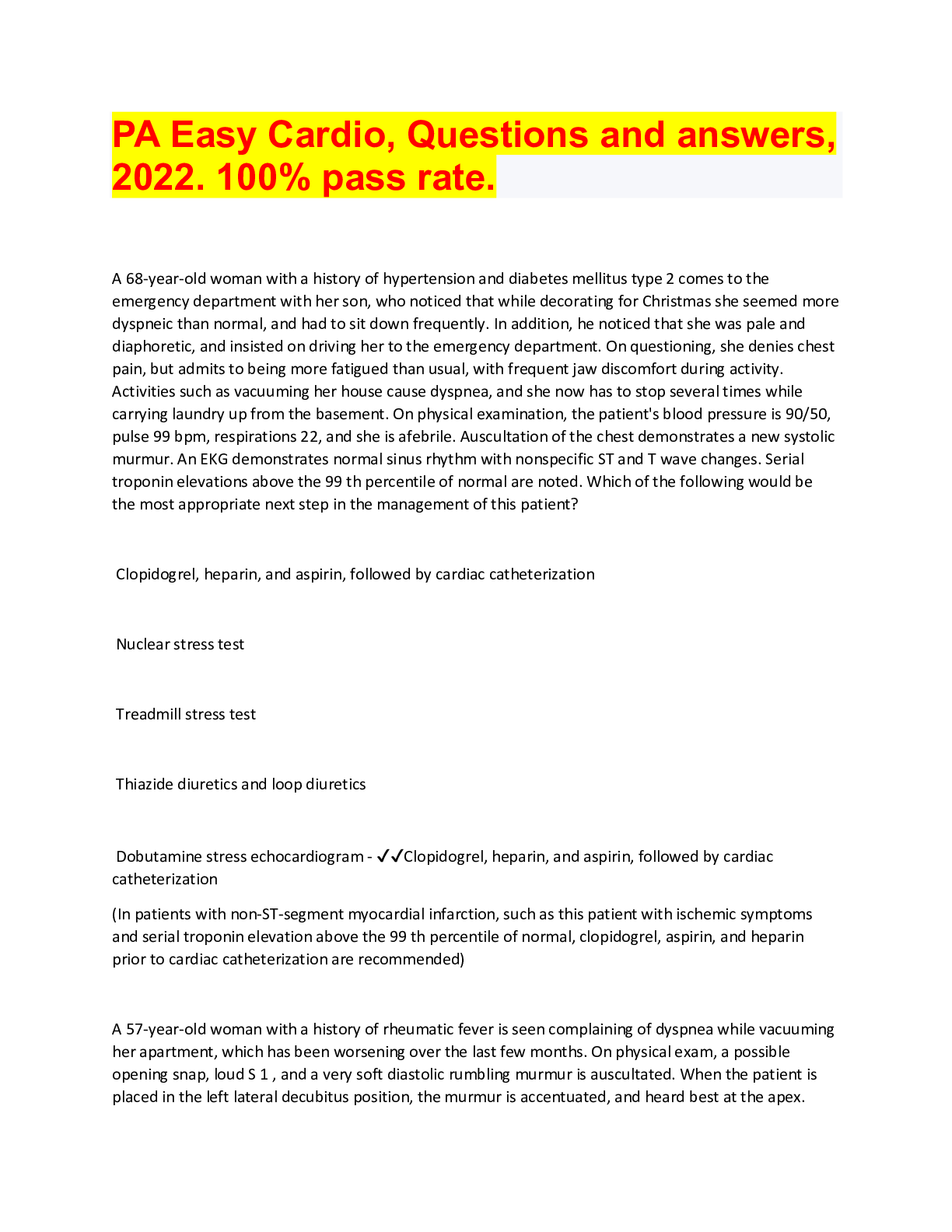
Instant download
Also available in bundle (2)
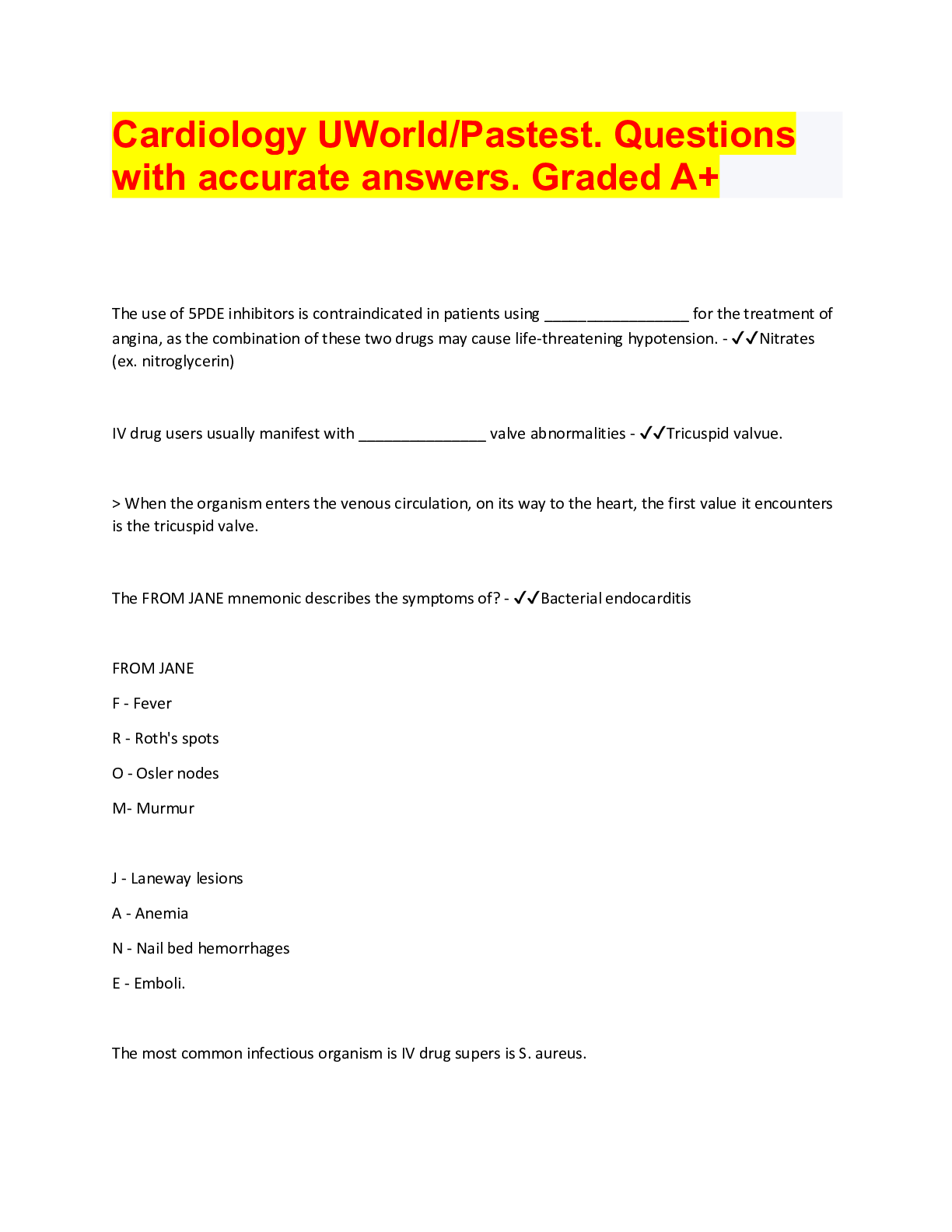
Cardiology BUNDLE, Questions and answers
All Cardiology exam papers questions with answers, download to score
By bundleHub Solution guider 1 year ago
$29
7

PA easy bundle, Exam Questions and answers, Rated A+
Comprises of exam Questions and answers, latest revisions for exams
By bundleHub Solution guider 1 year ago
$38
11
Reviews( 0 )
Document information
Connected school, study & course
About the document
Uploaded On
Aug 21, 2022
Number of pages
73
Written in
Additional information
This document has been written for:
Uploaded
Aug 21, 2022
Downloads
0
Views
100
















